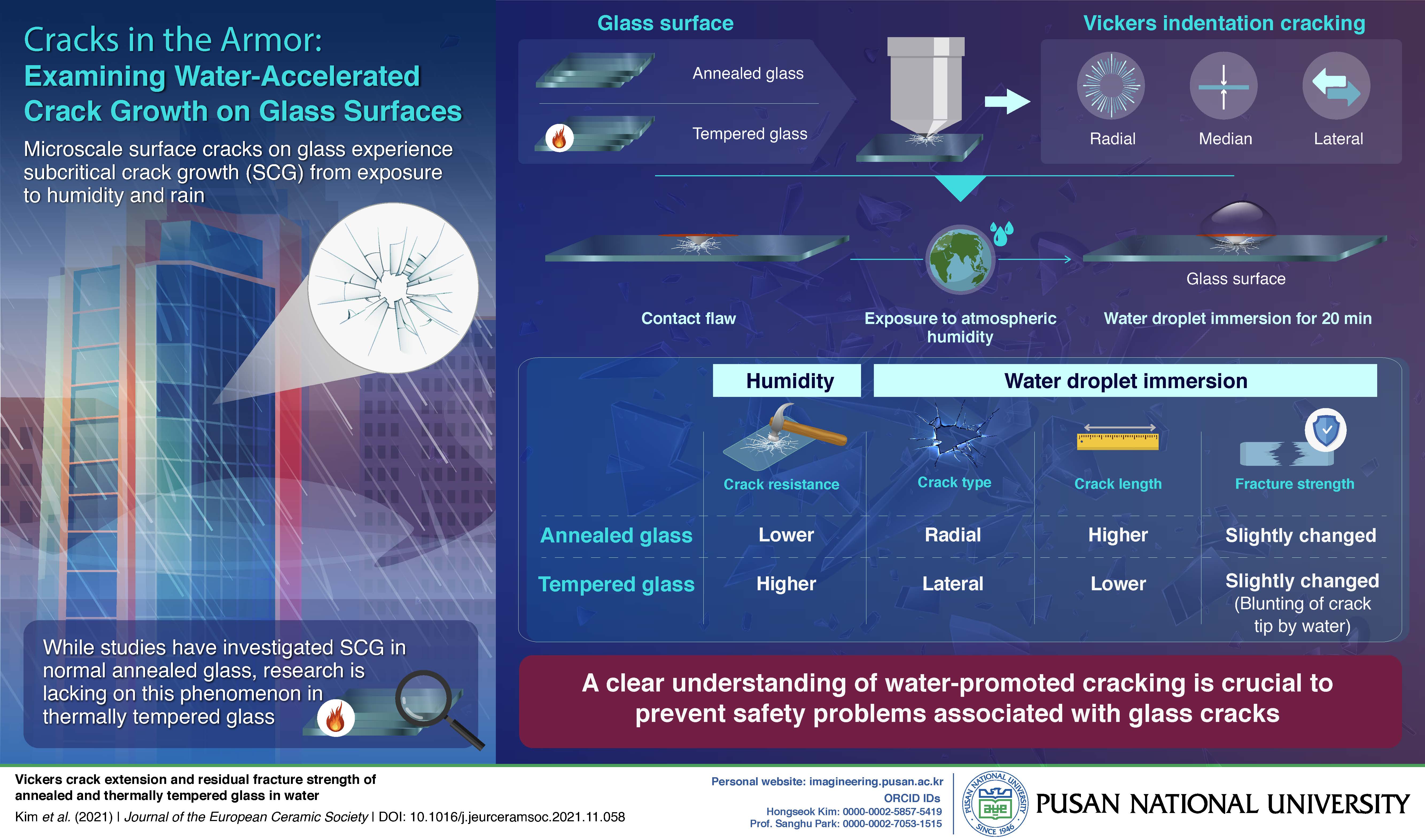
Pusan National University Study “Cracks” Mystery of Water-Promoted Fracture Growth on Glass
Pusan National University Study “Cracks” Mystery of Water-Promoted Fracture Growth on Glass
Scientists experimentally investigated the water-induced cracking behavior around contact flaws on annealed and tempered glass surfaces
Glass windows are exposed to harsh environmental stresses for extended periods of time. This creates tiny “contact flaws” on their surfaces, which grow when they encounter water droplets. To understand the mechanisms behind this phenomenon, a team of researchers from Pusan National University, Korea, examined this water-promoted cracking behavior on two widely used types of glass. Their findings provide important insights for engineers and designers into the causes of glass fracture.

Glass windows often endure external environmental factors such as wind, rain, and humidity, which lead to the formation of microcracks in their surface. For instance, a gust of wind can propel sand onto a window and create microscale surface cracks due to the impact of sharp-edged sand particles. These microcracks then grow in size when aggravated by water droplets and humidity.
When water comes in contact with these surface flaws, it penetrates the microcracks and slowly dissolves the silicon-oxygen bonds. This chemical attack breaks the glass networks which gradually degrades the mechanical strength and optical properties of glass structures. This environmentally enhanced crack growth process is known as stress corrosion or subcritical crack growth (SCG). The depreciation of mechanical performance due to SCG raises safety concerns for skyscrapers and high-rise buildings.
Recently, scientists have taken an interest in the effect of SCG on two widely used types of soda-lime glass: annealed and tempered glass. However, most studies have focused on establishing crack growth rates, and not much is known about the effect of water on the propagation of crack flaws. Additionally, many of the studies investigated the microcrack propagation dynamics of annealed glass and not tempered glass.
To address this gap in research, a team of researchers from Pusan National University (PNU) led by Prof. Sanghu Park, explored the mechanisms associated with water-promoted cracking behavior around surface micro flaws in both annealed and tempered glass in a study published in the Journal of the European Ceramic Society. Prof. Park explains, “Thermally tempered glass is of great commercial importance; it is used in displays, protection covers, vehicular windows, and others. The crack propagation of tempered glass is different from that of annealed glass by water droplets. So, it’s really important to understand how water droplet
promotes cracking behavior in different types of glasses.”
To emulate surface microcracks, the researchers created artificial flaws on a glass surface using a Vickers indenter—an instrument used to test the hardness of a material. Then, the samples were exposed to atmospheric humidity and water to analyze crack growth. The team discovered that the maximum length of crack growth was much lower in tempered glass than annealed glass. A subsequent 24-hour water immersion text revealed the formation of radial cracks in annealed glass and lateral cracks in tempered glass.
The comparative study provides new insights into the origin of glass cracks which can be useful for glass designers, engineers, and architects. “With an increase in typhoon and storm frequencies due to global warming, we need to find out new ways to protect the exterior of glass windows. We tried to understand the interactions between water and surface cracks to help solve safety problems associated with glass windows and structures”, concludes Prof Park.
Reference
|
Authors: |
Hong-Seok Kim a and Sang-Hu Park b |
|
Title of original paper: |
Vickers crack extension and residual fracture strength of annealed and thermally tempered glass in water |
|
Journal: |
Journal of the European Ceramic Society |
|
DOI: |
10.1016/j.jeurceramsoc.2021.11.058 |
|
Affiliations: |
a Graduate School of Mechanical Engineering, Pusan National University b School of Mechanical Engineering and ERC/NSDM, Pusan National University |
*Corresponding author’s email: sanghu@pusan.ac.kr
About Pusan National University
Pusan National University, located in Busan, South Korea, was founded in 1946, and is now the no. 1 national university of South Korea in research and educational competency. The multi-campus university also has other smaller campuses in Yangsan, Miryang, and Ami. The university prides itself on the principles of truth, freedom, and service, and has approximately 30,000 students, 1200 professors, and 750 faculty members. The university is composed of 14 colleges (schools) and one independent division, with 103 departments in all.
Website: https://www.pusan.ac.kr/eng/Main.do
About the author
Prof. Sanghu Park is a Professor of School of Mechanical Engineering, and Director of the Center for Hybrid Innovative Manufacturing & Engineering sponsored by Korean Government at Pusan National University (PNU). He received his PhD in Mechanical Engineering from KAIST (Korea Advanced Institute of Science and Technology) in 2006. Before joining to PNU, he completed Postdoctoral research on nanoscale additive manufacturing and imprinting process at the Korea Institute of Machinery & Materials (KIMM). Currently, Prof Park and his group are working on laser-induced metal processes of cladding, additive manufacturing, post-processes for improving mechanical properties and metal-nonmetal combining for higher characteristics.
Personal website address: http://imagineering.pusan.ac.kr
ORCID id: 0000-0002-7053-1515
 PURCS_45_Infographic_final.jpg
(1011KB)
PURCS_45_Infographic_final.jpg
(1011KB)